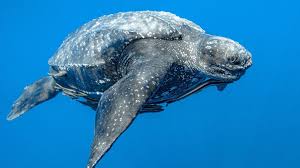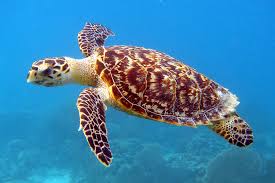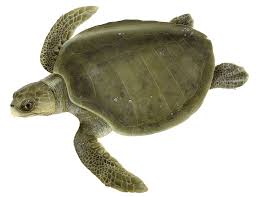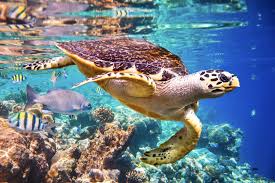Sea turtles are slow growing and long-lived. Their complex life history patterns encompass a diversity of ecosystems from terrestrial habitats where oviposition and embryonic development occur to developmental and foraging habitats in coastal waters (neritic zone) as well as in the open ocean (oceanic zone).
A. Leatherback Sea Turtle: Biology and Conservation

1. Taxonomy and Physical Characteristics
The leatherback sea turtle (Dermochelys coriacea) is the largest of all living sea turtles and the fourth largest modern reptile behind three crocodilians. It is the only living species in the genus Dermochelys.
This species can easily be differentiated from other modern sea turtles by its lack of a bony shell. Instead, its carapace is covered by skin and oily flesh. Dermochelys coriacea is the only extant member of the family Dermochelyidae.
2. Habitat and Migration Patterns
Leatherback turtles primarily inhabit the open ocean. Scientists tracked one individual that swam from Indonesia to the U.S., covering 20,000 kilometers (12,427 mi) over 647 days.
These turtles follow jellyfish prey, leading them to deeper waters during the day and shallower waters at night. This foraging behavior often takes them into extremely cold waters, with one individual observed hunting in waters as cold as 0.4 °C (32.7 °F).
Preferred breeding beaches are mainland sites facing deep water, with coral reef-protected areas typically avoided.
3. Feeding Behavior and Ecological Role
Adult D. coriacea turtles subsist almost entirely on jellyfish, playing a crucial role in controlling jellyfish populations. They also consume other soft-bodied organisms, such as tunicates and cephalopods.
Pacific leatherbacks migrate approximately 6,000 miles across the Pacific from nesting sites in Indonesia to feed on jellyfish off the California coast. A major threat to their survival is plastic pollution, as they often mistake floating plastic bags for jellyfish.
An estimated one-third of adult leatherbacks have ingested plastic. Marine debris ingestion can obstruct digestive tracts, dilute nutrients, and delay sexual maturation, impacting reproductive success. High-risk areas for plastic ingestion include waters offshore of San Francisco Bay, the Columbia River mouth, and Puget Sound.
4. Decomposition and Ecological Impact
Decomposing leatherback carcasses that wash ashore create micro-ecosystems. A 1996 study documented sarcophagid and calliphorid flies infesting a carcass opened by vultures, followed by beetles from Scarabaeidae, Carabidae, and Tenebrionidae families.
Later stages attracted Histeridae, Staphylinidae beetles, and anthomyiid flies, with over a dozen families participating in decomposition.
5. Life Cycle and Reproductive Biology
Like all sea turtles, leatherbacks begin as hatchlings emerging from nesting beaches. Predation by birds, crustaceans, and humans significantly reduces survival rates before they reach the ocean. Juveniles spend more time in tropical waters than adults.
Adults undertake long migrations between cold feeding grounds and tropical nesting beaches. Atlantic females tagged in French Guiana have been recaptured as far away as Morocco and Spain.
Mating occurs at sea, with males remaining aquatic while females come ashore to nest. Courtship involves head movements, nuzzling, and flipper displays. Females nest every two to three years, though annual breeding is possible. Fertilization is internal, often involving multiple males.
Unlike other sea turtles, leatherbacks may choose different nesting beaches within a region, preferring soft sand and shallow approach angles. Females excavate nests above the high-tide line, laying up to nine clutches per season with an average of 110 eggs per clutch (85% viability).
Embryonic development pauses during gastrulation, resuming after 20–25 days. Hatchlings emerge after 60–70 days, with sex determined by nest temperature. Nesting seasons vary geographically: February–July in Costa Rica, March–August in French Guiana, and February–July in the Atlantic from South Carolina to Suriname.
Read Also: 18 Medicinal Health Benefits Of Maidenhair Tree (Ginkgo Biloba)
B. Hawksbill Sea Turtle: Anatomy and Ecology

1. Physical Characteristics and Identification
Eretmochelys imbricata exhibits a typical marine turtle body shape, with flipper-like limbs for swimming. Adults average 1 metre (3 ft) in length and 80 kg (180 lb), though the largest recorded weighed 127 kg (280 lb). The carapace features an amber background with black and brown streaks and serrated posterior margins due to overlapping scutes.
Distinctive traits include a sharply hooked beak and two visible claws on each flipper. The carapace has five central and four lateral scutes, with a saw-like rear edge.
2. Global Distribution and Subpopulations
Hawksbills inhabit tropical reefs across the Indian, Pacific, and Atlantic Oceans. Major subpopulations exist in the Atlantic and Indo-Pacific regions, with nesting sites concentrated in remote islands.
3. Habitat Preferences and Migration
Adults frequent coral reefs, resting in caves and ledges. Juveniles are pelagic, transitioning to reef habitats at ~35 cm (14 in) in length. Hawksbills display site fidelity but may relocate to similar habitats.
4. Diet and Feeding Adaptations
Hawksbills are omnivorous but primarily consume sponges (70–95% of their diet in the Caribbean). Selective feeding targets specific sponge orders (Astrophorida, Spirophorida, Hadromerida), including toxic species like Aaptos aaptos. They also eat algae, cnidarians, and jellyfish, even preying on venomous species like the Portuguese Man o’ War (Physalia physalis).
5. Reproductive Behavior and Life Stages
Mating occurs biannually in secluded lagoons. Atlantic hawksbills breed April–November, while Indian Ocean populations mate September–February. Females lay ~140 eggs per clutch, with hatchlings emerging after ~60 days.
Juveniles lead a pelagic existence until reaching ~35 cm. Maturity is estimated at 30+ years, with lifespans of 30–50 years. Sexual maturity varies by region: 10–25 years in the Caribbean, 30–35 years in the Indo-Pacific.
Read Also: 19 Medicinal Health Benefits Of Avens (Geum)
C. Olive Ridley Sea Turtle: Population Dynamics and Behavior

1. Taxonomy and Physical Description
Lepidochelys olivacea is a small sea turtle averaging 60–70 cm in carapace length. The heart-shaped shell has variable lateral scutes (5–9 per side) and ranges from grayish-green to olive. Hatchlings are dark gray with serrated margins, smoothing with age.
Adults exhibit sexual dimorphism: males have longer tails, tapered carapaces, and concave plastrons, while females have domed shells.
2. Global Distribution and Population Trends
Olive ridleys inhabit tropical waters worldwide, with major populations in the Pacific and Indian Oceans. Historical abundance (e.g., 10 million in Pacific Mexico) has declined sharply due to exploitation, with current estimates suggesting ~852,550 nesting females globally.
3. Reproductive Ecology
Mating occurs offshore, with females nesting in synchronized arribadas (mass nestings). Peak nesting in the eastern Pacific occurs September–December.
Clutch sizes average 105–116 eggs, incubating for 45–70 days. Temperature-dependent sex determination results in females at 31–32°C and males below 28°C.
4. Feeding Habits and Habitat Use
Primarily carnivorous, olive ridleys consume jellyfish, tunicates, crustaceans, and fish eggs. They forage in shallow coastal waters but may venture into open oceans. Cannibalistic tendencies have been observed in captivity.
5. Conservation Challenges
Threats include bycatch, habitat loss, and pollution. Protective measures focus on safeguarding nesting beaches and reducing plastic waste in marine environments.
Do you have any questions, suggestions, or contributions? If so, please feel free to use the comment box below to share your thoughts. We also encourage you to kindly share this information with others who might benefit from it. Since we can’t reach everyone at once, we truly appreciate your help in spreading the word. Thank you so much for your support and for sharing!

